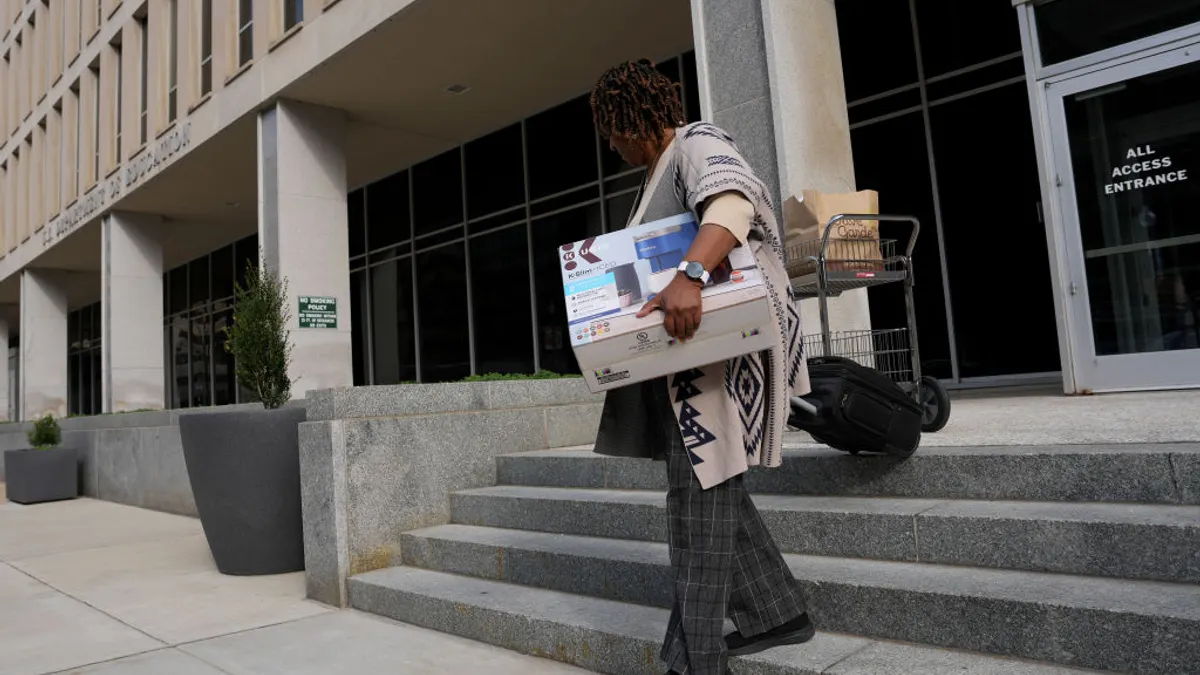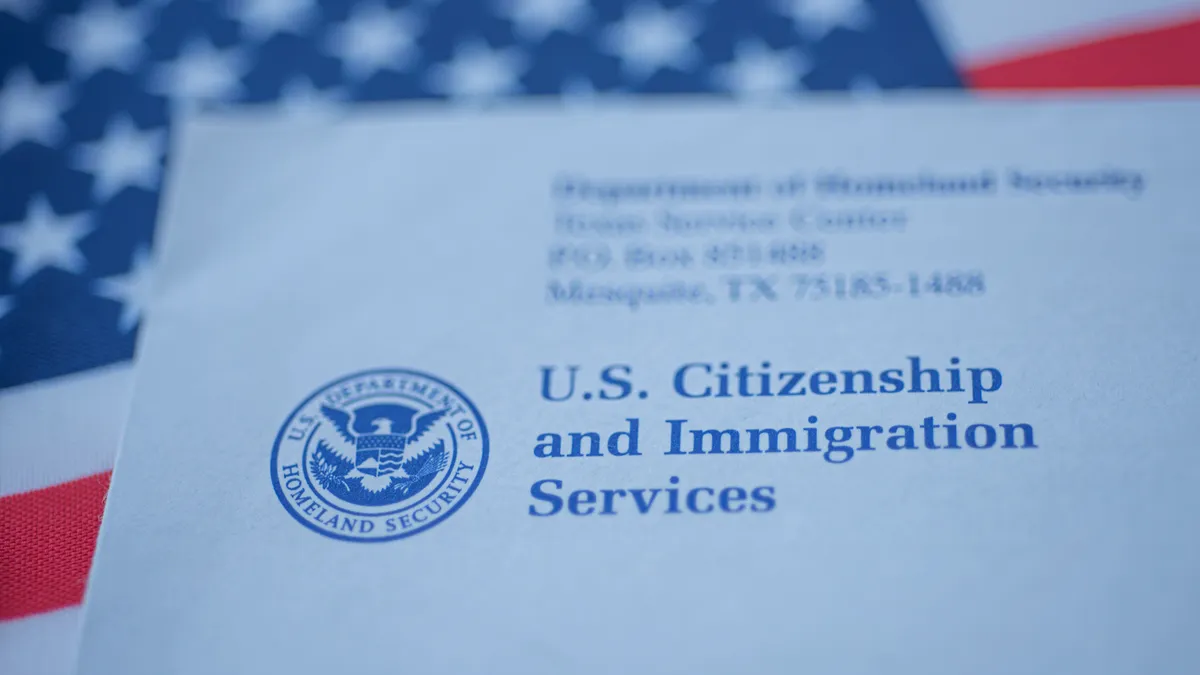Strained budgets. Growing cybersecurity threats. Looming curriculum restrictions and book bans. An influx of artificial intelligence in classrooms. These are just a few of the hurdles — and opportunities — schools are facing at the start of the new year.
Add to that the changes likely to be on the horizon under a new presidential administration: With President-elect Donald Trump returning to the White House on Jan. 20, K-12 administrators will need to be on the lookout for changes in funding, directives around classroom content, and more responsibility placed at the state and district levels.
Here are six trends that will be essential to watch as 2025 gets underway.
Rising costs and limited funding will put stress on budgets
Districts are facing an array of financial challenges this year, although some localities may be more affected than others.
One of the biggest barriers for some districts will be the expiration of federal American Rescue Plan funds — the last and largest of federal COVID-19 emergency aid that has helped schools recover from pandemic hardships since 2020.
The spending deadline for ARP is Jan. 28, 2025, although some districts will have a longer off-ramp as they requested and received more time to spend down the funds. High-poverty school districts, which got more emergency funding, are expected to encounter more difficulty transitioning away from ARP.
Other factors stressing public school budgets include increased costs in staff compensation and elsewhere, and decreasing enrollments due to lower birth rates and competition from school choice programs, according to Moody's Ratings outlooks issued in December.
As a result of squeezed budgets, districts may have to make tough decisions like closing underenrolled, low-performing schools, according to predictions from Edunomics Lab at Georgetown University and the Thomas B. Fordham Institute.
However, while some K-12 experts are discouraged by the financial picture, others are more optimistic that promises from the incoming Trump administration to reduce federal spending and give more autonomy to states will fuel innovation and efficiency.
President-elect Trump has called for closing the Education Department to reduce bureaucracy and send federal funding and programming to the states to manage, which some say would lead to cost savings. Trump and his supporters also want to expand school choice by allowing more taxpayer funding to be used for private school vouchers. Proponents say school competition would drive improvements in efficiencies and student outcomes.
Public school advocates, on the other hand, say private school choice programs have fewer accountability systems and take money away from public schools, which educate most school-aged children.
Staffing shortages will continue as cuts impact high-needs schools
Even as schools report the need for more staffing, some researchers foresee a slowdown in hiring and a likely surge in teacher layoffs.
Though half of public school leaders reported feeling understaffed last year in a National Center for Education Statistics survey, fewer schools reported operational impacts — like increasing class sizes or using staff outside of their intended duties — due to staffing shortages.
High-poverty schools are expected to feel the brunt of teacher layoffs in 2025, said Dan Goldhaber, director of the Center for Analysis of Longitudinal Data in Education Research at the American Institutes for Research. That’s because student enrollment is still on the decline, and the historic one-time pandemic relief funds disproportionately went to high-poverty schools — and will not be renewed.
“So the end of that money means that there's got to be at least some pretty significant chunk of teachers in high-poverty schools that are going to lose their jobs,” said Goldhaber, who is also director of the Center for Education Data & Research at the University of Washington.
Special education was also top of mind, as shortages in those roles continued into 2024, and as the U.S. Commission on Civil Rights is expected to release its investigation findings later this year regarding federal efforts to address the issue.
The already strained special education system will face more pressure
Services for students with disabilities will play a major role in the new year as several factors put a squeeze on the already stressed system. For one, the population of students served under the federal Individuals with Disabilities Education Act, including those with autism, has been increasing.
The expanded population means schools need to conduct more evaluations and provide more individualized services.
As an example, Michigan's Ann Arbor Public Schools conducted 481 initial special education evaluations during the 2023-24 school year — up from 178 in the 2020-21 school year, Concetta Lewis, an assistant superintendent in the district's special education office, told the U.S. Commission on Civil Rights in December.
At the same time, the field faces severe staff shortages that are impacting the quality and timeliness of students' services, several speakers testified during a November briefing and December listening sessions held by the commission, which is researching the issue.
"I would hire every social worker that I could to meet the increased social, emotional and mental health needs of the students we are serving," Lewis said.
Concerns that the U.S. Department of Education will be downsized or eliminated under the incoming Trump administration, as well as public schools’ growing competition from school choice, are fueling special education advocates to speak out in support of a strong, well-funded public special education system.
However, there are Republican priority projects that special education experts embrace, including more attention on career and technical education opportunities and increased collaboration and transparency with families.
The new year will also see a milestone for special education advocates: Nov. 29 will mark the 50th anniversary of the signing of the landmark federal Education for All Handicapped Children Act, which was eventually reauthorized into the current-day IDEA.
The last time there was a comprehensive update to IDEA was in 2004. While many experts say the law as written is strong and does not need to be reauthorized by Congress, they are pushing for the federal government to contribute 40% of the additional per-pupil cost for special education services — a goal originally set back in 1975 during the law's creation.
The federal contribution stands at about 10% for fiscal year 2025, leaving states and districts to make up the difference.
Book bans, curriculum restrictions — and challenges to both — will proliferate
In response to a sharp uptick in book bans and curriculum restrictions in recent years, experts expect a rise in challenges from parents and local organizations against these efforts in the coming years.
At the same time, it's likely that Democratic-leaning states will continue to adopt laws prohibiting book bans, also known as Freedom to Read laws, says Kasey Meehan, program director of PEN America's Freedom to Read initiative. In January, a New Mexico state representative introduced a similar bill, known as The Librarian Protection Act, ahead of the state’s 2025 legislative session.
Nationally, school book bans tripled between the 2022-23 and 2023-24 school years, according to data released in November by PEN America, a free speech advocacy organization tracking the issue.
In total, the 2023-24 school year saw 10,046 cases of banned books compared to 3,362 the year before. Most of the targeted titles featured characters of color or LGBTQ+ characters, as well as sex and sex-related topics.
Though Meehan said she hopes book bans will stop climbing into 2025, she will be watching Congress to see if the Republican majority will pass legislation mirroring policies from conservative-leaning states. These bills might include limiting students’ access to certain instructional content. For instance, such a proposal could target critical race theory or LGBTQ+ content as has been done legislation in Florida or Iowa, she said.
During his campaign, President-elect Donald Trump called for federal funding cuts to schools that promote critical race theory and “other inappropriate racial, sexual, or political content.” In his first administration, Trump’s push to preserve U.S. history sparked a movement at state and district levels to censor curricula.
Lawsuits challenging book bans inched closer to reaching the U.S. Supreme Court last year, but it’s still unclear if the high court will resolve the matter in 2025, Meehan said.
More funding and support for cybersecurity funding will be needed
The combination of limited protections and lucrative data will continue to present cybersecurity challenges for K-12 schools.
During a Dec. 10 webinar hosted by K12 Security Information Exchange, known as K12 SIX, the national school cybersecurity nonprofit’s co-founder and director, Doug Levin predicted areas to watch regarding K-12 cybersecurity.
One prediction is that districts may require vendors to provide more safeguards to protect online privacy and security in schools. Vendors "told us that they take our privacy and security very seriously, and obviously that's important, and we want to believe them and trust them. But I think we're moving to a place now where we're going to be asking people to prove it," Levin said.
Other cybersecurity trends that Levin forecast for 2025 include:
- Districts will debate if and how to build cybersecurity costs into their operating budgets.
- School systems will work to bolster their resilience to cyberattacks to curtail recovery response times.
- Districts will focus on specific and targeted cybersecurity advice and guidance that is based on their unique cyber infrastructure and operations.
- The education sector will look to strengthen collaboration to prevent and respond to cyberthreats.
"This is a sectorwide issue. This is affecting schools of all types and sizes, all across the nation, frankly, all across the world," Levin said. "It is in our best interest to work together, to share that load, to figure out what best practices are."
In 2024, the federal government's involvement in school cybersecurity issues deepened as the White House, U.S. Department of Education and other federal agencies added resources and funding to support districts amid an increase in cyberincidents, including ransomware.
It costs school systems an average of between $50,000 to $1 million for every cybersecurity incident due to expenses for downtime and recovery, according to a 2022 report by the U.S. Government Accountability Office.
To help combat cyber threats, the Federal Communications Commission created a $200 million cybersecurity pilot program for schools and libraries. In November, FCC announced it received $3.7 billion in requests to participate in the pilot.
States will bear more burden in school AI guidance
Within the past two years, the U.S. Department of Education has released several resources to help school districts, teachers and ed tech companies navigate the use of artificial intelligence tools in the classroom.
But as a second Trump administration transitions into the White House, it’s unlikely that schools will see more federal guidance on AI in a K-12 context, said Pat Yongpradit, chief academic officer of Code.org and lead for TeachAI. Federal efforts could take a step back because the Biden administration has “done so much already,” and there’s an expected change in priorities under Trump, Yongpradit said.
Instead, Yongpradit said, the onus to guide schools on AI will fall on states in 2025.
What that looks like will vary, Yongpradit said. The ramping up of such initiatives could include developing K-12 AI taskforces, providing statewide professional development grants, and offering innovation grants to support the piloting of AI tools in schools.
As of November, TeachAI found 24 states had released AI guidance for schools. Yongpradit said he expects up to 32 states in total will continue to put out guidance in the new year. TeachAI is a national coalition of nonprofits, education authorities, researchers, associations, nongovernmental organizations and technology companies that aims to guide schools on safe and ethical AI use. Code.org is a nonprofit that provides computer science curriculum and programs to schools.
In addition to an increase in state guidance, Yongpradit said he foresees more district-level AI policies — especially in the wake of a high-profile lawsuit filed against a Massachusetts school district in October over its lack of an AI policy. “So a lot of people, just for the sake of covering their butts, they're going to want to have guidance on the books,” he said.






















